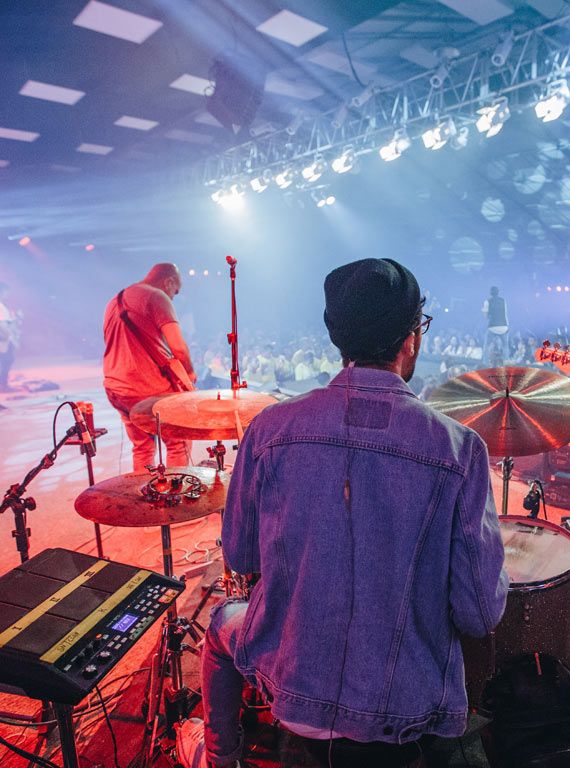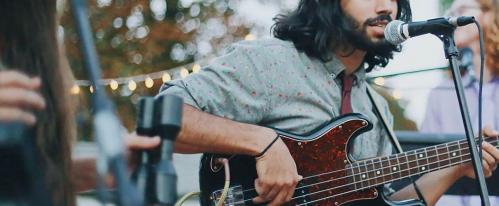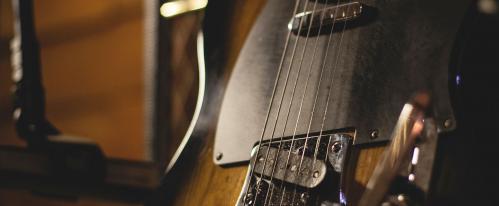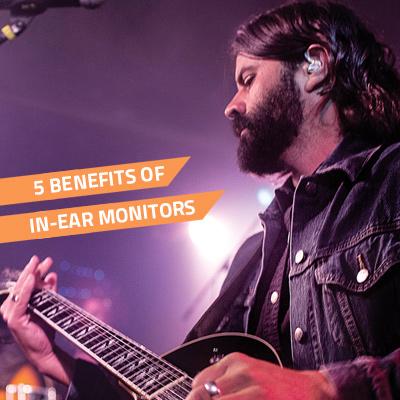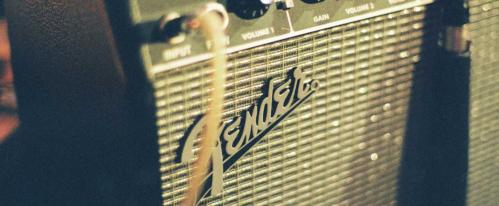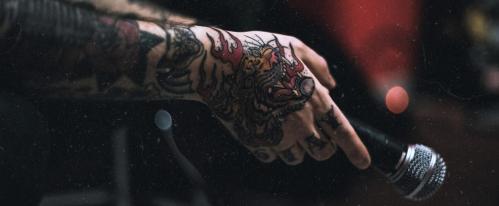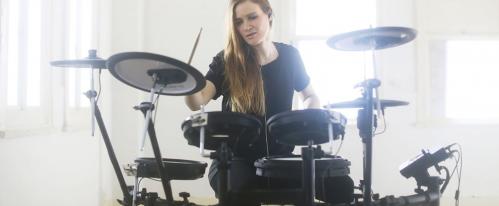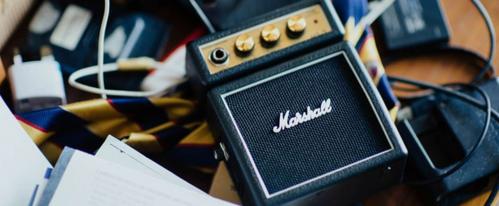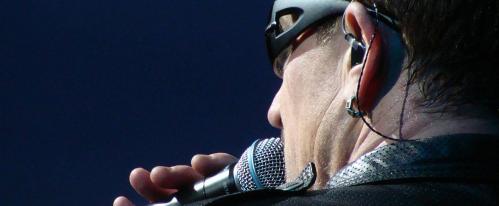Read our essential live band equipment list if you're thinking of taking your band to the stages of the world. Here, we'll round up all the essential gig equipment you need to play live.
If you're wondering "what equipment does a band need?" we're here to help with our essential live band equipment list. With this comprehensive band equipment list we'll help you make sure your band are prepared for your next gig/tour . We'll offer up a rundown of each band member and look at the gig equipment and musical gear they are expected to take to a gig, with some advice on what to look out for when buying that gear.
Band Equipment List Summary:
Before we get into the details, here's a list of gig equipment that each member needs in summary:
- Singer - Your own microphone, In ear monitors
- Guitarist - 2 x guitars, pedals, leads, amplifier, plectrums
- Bass - 2 x bass guitars (at least 1) pedals, leads, amplifier
- Drummer - your own kit (headlining), breakables such as snare and sticks, hardware, stool, cymbals
- Keyboard - your own keyboard, leads, effects pedals (if applicable)
- All members - in ear monitors if required, PA system if you're setting up a DIY gig
THE SINGER - WHAT GIG EQUIPMENT DOES A SINGER NEED?
The singer has the easiest job out of them all when it comes to bringing along the gear. If you are playing in a venue that regularly has bands in, the chances are they will already have the frontman's gear set up and ready including microphone and mic stand, as well as PA system and monitor speakers. All the singer has to do is turn up, but we do recommend buying your own mic for health and safety reasons!
In summary, a singer will need their own microphone - that's about it! However, most venues can supply you with one on the day.
If you are playing in a venue that does not have a PA system, the singer will be expected to bring along a PA system, a dynamic microphone, a microphone stand and an XLR cable.
If you do need to bring your own PA, here's a little background info you should read up on.
WHAT IS A PA SYSTEM?
A PA system stands for "public address system" and is made up of an amplifier that is connected to a speaker. You plug in a microphone to the amplifier and - you guessed it - your voice can be heard through the speaker. There are two types of PA systems - active (powered) and passive (un-powered). An active PA system is more simple to set up/use as the PA amplifier is built-in to the speakers, whereas a passive PA system are more complex to buy, set up, maintain and get a good sound out of.
If you're just starting out and need a PA system for rehearsal we recommend a powered/active PA system.
ACTIVE VS PASSIVE PA SPEAKERS
We recommend an active PA system for small bands as they are generally more reliable, compact and are easier to get sounding professional. Passive speakers should only be used if you know how to match an amplifier with speakers otherwise you will find yourself running up expensive repair bills rather frequently. We recommend the likes of the Alto TX2 series speakers as well as the QSC range of active speakers.
We recommend reading:
WIRING PASSIVE SPEAKERS - SERIES OR PARALLEL?
If you DO have a passive PA system, here's how to wire a Passive PA system up for beginners:
The way you wire your speakers to your amplifier has an effect on the impedance. Wiring your speakers in a parallel series will decrease the amount of ohms. For example, if you wire two 8 ohm speakers in parallel the impedance will be 4 ohms. Four 8 ohms speakers in parallel would be 2 ohms. Wiring your speakers in series will increase the impedance by adding together the ohms. For example, two 8 ohm speakers would be 16ohms.
Make sure your amplifier matches up with the impedance (ohms) of your speaker setup - otherwise, you risk damaging your amplifier/speakers. For this reason, we recommend active speakers as they are much easier to setup - you simply plug in and you are ready to play. Check out our blog if you want to know The Difference Between Active and Passive PA Speakers.

FLOOR MONITORS VS IN-EAR MONITORS FOR SINGERS
Floor Monitors
When performing, and singing especially, you need to be able to hear yourself.
The main PA speakers will be aimed towards the audience, so you will have a hard time hearing yourself. Floor monitors are commonly used at gigs on the edge of the stage, pointing towards the band. This allows you and the rest of the band to hear exactly how you sound and can consequently improve your pitching - it is not recommended to sing without a monitor. Floor monitors plug into your amp/mixer and are extremely easy to set up, but if you have it too loud it can cause feedback and contribute towards the risk of hearing damage.
In ear monitors
In-ear monitoring allows you to move around freely without needing to stand where you can hear the monitor. You eliminate any chance of feedback and free up some extra space on stage, and they're relatively easy to set up. Here's an example of how in-ear monitoring works:
You can read our best in ear monitor systems blog HERE.
WHICH TYPE OF MICROPHONE DO I NEED FOR LIVE SINGING?
There are a few different types of microphones out there that are good for different situations. When playing live or even rehearsing, it is strongly recommended that you use a cardoid dynamic microphone. They are sturdy enough to live up to the demands of gigging musicians, and a lot less sensitive than other types - meaning you won't pick up the sounds of anyone else on stage or your drummer behind you. Many people would suggest a Shure SM58 as the best dynamic mic but there are plenty of others out there that sound great too. Sennheiser, SE Electronics and even the newer brands like Tourtech in particular, make some brilliant microphones that give the SM58 a run for its money.
WIRELESS VS WIRED MICROPHONE
If you are going to be moving a lot on stage or your performance involces audience interaction or for you to leave the stage, then a wireless microphone would be the best option. They are convenient and make the stage a lot more tidy, but cost a lot more and can be awkward to set up. If you are using multiple wireless microphones you run the risk of interference - especially if you are using any wireless in-ear monitoring. There is a debate about the quality of wireless microphones - most people believe the sound quality is the same as a wired microphone, especially in live situations.
However, one wireless system might sound great with a 2nd tenor singer, yet may sound great with a soprano. If you can get a chance, it is worth testing a wireless microphone with the voice/instrument you plan on using it with to ensure you get the sound you are expecting. If you can make do without wireless, wired is cheaper and simplifies your setup. Also needed is a mic stand and XLR cable and then that's your frontman sorted for the bare essentials.
What's the best vocal mic for Live singers?
There are a few options available to you, but overall we think these three options are easily some of the best live vocal mics.
Shure SM58
The Shure SM58 Dynamic Microphone is an industry standard live microphone and Shure's most popular cardioid dynamic mic.
Almost every venue you ever go to will have one of these available as they're simply the best. A built in wind shield stops plosive noises and the rugged pneumatic shock mount system cuts down handling noise.
In terms of sound, this microphone rejects background noise and isolates your voice extremely well. This is essential singing equipment for gigs and should be on the top of every singers list when it comes to equipment for gigs.
there are of course upgrade versions which Sam & Meg discuss in the Shure SM58 vs Beta 58A vs Beta 87A comparison below!
Shure PGA58BTS Vocal Microphone Kit
If you're just starting out in the world of live singing and performance, you should consider the Shure PGA58BTS kit.
This is essential singing equipment for gigs as you get a Shure PGA58 microphone, tripod microphone stand, 4.6m XLR to XLR cable, microphone clip and stand adapter all in one package.
The Shure PGA58 mic features a cardioid polar pattern which is what you need for singing live and rehearsal jam sessions whilst the rugged housing protects the capsule and will last many years of hard gigging. Ideal for new singers and performing musicians.
Sennheiser E835 Dynamic Vocal Microphone
The Sennheiser E835 Dynamic Vocal Microphone offers clear audio and minimal interference which makes it a great option for singers who might sing at lower volumes.
The frequency response of 40 - 16000 Hz means that it can handle spoken word exceptionally well and still handle the screaming vocalists too!
Again, you have a cardioid pickup pattern and built-in pop shield for clarity - a great piece of essential gig equipment for singers.
THE GUITARIST - WHAT GIG EQUIPMENT DOES A GUITARIST NEED?
Guitarists have to bring their own gear - but this isn't a bad thing! Getting the right tone is a difficult thing to do, and the only way to be consistent with this is to use the same gear at each gig. If you used the same guitar through a Fender amp and a Marshall amp, both would sound completely different to one another. So it makes sense to use the same gear all the time.
In addition, it's best to ALWAYS bring your own gear rather than relying on borrowing amps and guitars. it's not only better for your sound, it's also professional to turn up with everything.
So what gig equipment does a guitarist need?
In summary a guitarist's live band equipment list should include:
- 2 x guitars (in case a string breaks on one)
- Guitar pedals (if you use them)
- Tuner pedal (ESSENTIAL!)
- Guitar leads/cables
- Amplifier
- Microphone (if you sing and don't want to use mics provided by the venue)
IS YOUR GUITAR GOOD ENOUGH TO GIG WITH?
Picking a guitar is a very personal task. The old saying "one man's trash is another man's treasure" applies here. In the end, when you choose a guitar you should base your choice on the feel and the sound of the guitar - does it feel good in your hands? Does it sound good? do you actually like it?
Some guitars that are fine for home practice just don't make the cut when it comes to gigs, so if you're going to start gigging, we recommend investing a little more money into good quality guitars.
What are some signs that my guitar isn't good enough for gigging?
Signs that your guitar might not be up to scratch are: having to tune it in every time you want to play it, a loud "hum" when playing through the amp at low-medium volume, and regular string breakage. Upgrades such as new machine heads, pickups and bridges can solve these issues, but sometimes the upgrade cost can total more than the guitar is worth. There are some great intermediate guitars out there that may be a better option than upgrading.
If you're just starting out, we recommend checking out our best cheap guitars that don't suck blog HERE.
Can I improve my existing guitar? What mods can I make to my guitar?
If you are experiencing any problems such as a buzzing noise on the frets or you think your guitar doesn't feel right to play, you might benefit from a professional setup. There are many experienced luthiers that can do wonders to a guitar - and having a bad setup can make even the most expensive of guitars feel bad to play.
Check out our easy guitar mods video and improve your guitar today!
WHICH GUITAR SHOULD I BUY?
The two main elements that affect the tone of a guitar are the type of wood used and the pickups. For this reason, some guitars are "better" suited for certain types of music than others. For rock/high-gain tones you might find Gibson, Epiphone and PRS to your liking as they use humbucking pickups, whereas clean enthusiasts might prefer a Fender, Squier or Rickenbacker as they often use single coils. Metalheads might go for Ibanez, Jackson and ESP.
These are only rules of thumb and a good player can make any guitar sound good - Adrian Smith used a telecaster to create the distinctive riffs of Iron Maiden - who said Telecasters couldn't do metal?!
Watch our how to choose an electric guitar video.
IS YOUR GUITAR AMP LOUD ENOUGH FOR GIGS?
Some guitarists may go as far as saying the amp is the most important part of a guitar rig. Whether you pick a valve or solid-state amp, it needs to be loud enough.
So how loud does an amplifier need to be for a gig?
We recommend no less than 20 watts for a valve amp, and no less than 50 watts for a solid-state. You can get by with 1x 12" speaker, but if you want to play festivals and hear yourself onstage we recommend spending a little bit more and getting a 2x 12". The extra headroom this gives you makes a huge difference - you might not notice it at home when practicing, but when you are gigging a 1x12 can sound pretty weak in a large room.
It doesn't matter whether you go for a combo or a head/cab setup - both have their pros and cons. Combos are slightly cheaper and take up less space, whereas you can swap in between cabs if you are using a head to try and get different tones. Some great options for a valve amp might be Orange, Fender and VOX, whereas solid-state fans might prefer something like or the Line 6 or BOSS Katana solid state amps. Again, it is all about personal preference.
We recommend checking out our best practice amps that you can still gig with video. These amplifiers are all fairly small sized amps that you can safely gig with and record with.
Great Gigging Guitar Amps
There's a massive range of gigging amps out there, but we'll highlight three industry standards below. before we do, we recommend reading our best combo amps for gigging blog HERE and our best affordable gigging amps blog HERE to give you an idea of what you should be spending.
BOSS Katana 100/212 MkII Guitar Amplifier
The BOSS Katana 100/212 MkII Guitar Amplifier is quickly becoming an industry standard gigging amplifier for those who need a wide variety of sounds.
Metal, Indie, Rock - This amp can do it all thanks to its 5 unique amp characters built in and range of effects. The 100 watt power ensures you're ready for gigs of all sizes.
Vox AC30C2 Custom Combo Valve Amp
The VOX AC30 amplifier is an industry standard valve amp that has been used by guitarists of all genres. We can pretty much guarantee you've heard the sound of this amp on a record you own!
The multi channel design means you can enjoy cystal clear cleans or start to drive the valves into saturaytion and enjoy the classic tube driven dirty tones.
Foo Fighters, Thrice, The Beatles - you name it the band's you know have used one!
If you want to go smaller, the VOX AC15 is a great option too.
Fender Champion 100 Guitar Amplifier Combo
The Fender Champion 100 Guitar Amplifier Combo is an incredible gigging combo amp that won't break the bank.
We love this amp as it provides 100 watts of solid state power and the classic Fender tones that guitarists love.
You have 2 channels at your disposal. Channel One delivers classic Fender clean tone based on amps like the Twin Reverb, whereas Channel Two has selectable amp voicing that allows you to cycle through a range of classic amp voices to find your preferred tone including blues, Jazz and more. You also have a range of effects built in, such as Reverb, Delay, Echo, Chorus, Tremolo and many more. Ideal gig equipment for guitar players of all genres.
MULTI EFFECTS OR PEDAL BOARD?
Multi-effects unit or a handful of your favourite pedals? This is a decision that all guitarists face, and is becoming harder and harder as multi-fx pedals become more advanced.


Individually building a pedal board has the obvious advantage of picking your favourite effects to get the best sounds possible. This can be quite expensive and means you need to invest in a pedal board and a multi-power supply but is worth all the effort once you have it setup.
A multi-effects unit has the convenience of everything in one place. One power supply, one pedal - with every effect you'll ever need. Navigating the menus can be a little more tricky than single pedals, but once you find the tone you want you can store it as a preset - no more losing your settings when your pedals are in transport! They work out cheaper and are recommended for guitarists that haven't yet decided which effects they need. Cables, picks and straps should also be remembered!
View our best multi effects pedals guide HERE. Or watch Sam's very useful video below.
THE BASS PLAYER - WHAT GIG EQUIPMENT DOES A BASS PLAYER NEED?
Much like the guitarist, the bassist will be expected to bring their own gear. However, some venues will handle bass differently.
Some sound engineers like to DI (direct input) into the PA system, meaning no amp is required, whereas some would expect you to bring your own amp along and use the di out of the amp in conjunction with the onstage sound. Either way, it is best to have one, and as previously mentioned, an amp can hugely affect tone. They also help you hear what you're playing on stage as bass is not always put through the monitors at a satisfactory level.
So what gig equipment does a bass player need?
In summary, a bass players live band equipment list should include:
- 2 x bass guitars (in case a string breaks on one)
- Effects pedals (if you use them)
- Tuner pedal (ESSENTIAL!)
- Leads/cables
- Bass Amplifier
- Spare battery for active pickups (if you use them)
- Microphone (if you sing and don't want to use mics provided by the venue)
WHICH BASS GUITAR SHOULD I BUY?
Four, five, or even six strings? How low will you go? Many bassists find that the traditional four strings is enough for their playing style, although some country bands and metal bands favour 5 string basses for the low B note as they are usually tuned to B-E-A-D-G. If you like to solo on your bass you may find the extra strings useful for some fancy fills, but they aren't for everyone.
The bassist needs to be happy with the feel of their bass. A smaller-scale length can make playing more comfortable for smaller players, and models with thin necks are available from Ibanez that might appeal to bassists that like to solo. The most popular basses around are from Fender - the Precision and the Jazz designs - which still remain unbeaten to this day.
Pickups and body wood are the main culprits when it comes to tone - choose active pickups for bright, percussive tones and choose passive pickups for warm, full tones. If you use active pickups, be aware that they require a battery to work. If you use active pickups and notice your bass sounding rather dull, you will need to replace the battery - make sure you have a spare one with you at all gigs!
Some of the worlds best bass guitars are made by the likes of Fender, Ibanez, Rickenbacker and Yamaha to name a few brands.
CAN YOU SHOW ME SOME OF THE BEST BASS GUITARS FOR LIVE USE?
Sure thing! In regards to bass guitars for live use, almost any bass that you feel you can rely on will be good enough for live use. However, as with all musical instruments it makes sense to spend as much as you can afford and get hold of a better quality option as you're less likely to have to upgrade later on down the line.
The following options are the most popular choices/shapes for bass players who play live.
Fender Precision Bass
The Fender Precision bass guitar is one of the most popular bass guitars in the world, and was actually the first every electric bass! So you know you're in good hands with one of these.
This bass guitar provides a powerful, versatile tone thanks to the split pickup that really respond to the changes you make via the tone pot. Start here when you decide to play live with a bass guitar!
If you're on a budget, the Squier Precision bass guitars are great!
Rickenbacker 4003 Bass
Next up we have one of the bass guitars almost all bass players aspire to one day own. The Rickenbacker 4003 Electric Bass pictured here in Ltd Edition Pillarbox Red is an incredible bass guitar that you will never have to upgrade.
This is a staple of live performance and we feel every bass player should at least try one of these out! The single-coil pickups provide all of the signature ringing sustain, treble punch, and solid underlying bass tones that make these bass guitars so sought after.
Available in more colours HERE.
Fender Jazz Bass
Next up we have the Fender Jazz Bass which is probably the 2nd most popular bass guitar after the Precision bass.
This ofers a slightly more versatile option as it features 2 pickups whcih you can blend or isolate, offering up far more sonic options. Although it's called a Jazz bass - it's suited to all genres of music.
If you're unsure of the differences between the Fender Precision and Jazz Bass guitars, we recommend reading our blog HERE.
HOW LOUD DOES MY BASS AMP NEED TO BE?
So you know that some venues might ask you to DI, and some will expect you to bring an amp. If you want to be heard with the rest of the band, it is recommended that your amp is at least 50w as a general rule of thumb. The most common size speakers found in bass amps are 10" and 15".
We feel that 10" speakers give a punchier sound and are lighter to transport, whilst 15" move more air and produce lower frequencies. You can get a great sound out of both speakers, and it is a matter of preference as to which is "better". Some bassists go as far as mixing a 2x 10" cab with a 1x 15" cab to get the perfect combination of high/low end.
A 100w head with a 1x 15" speaker or 2x 10" speakers would be enough for small-medium sized venues. If you want a more simple setup, a combo amp would be ideal - but get one that has an extra output to add another cab just in case you decide to expand your speakers in the future. Look out for Ashdown and Ampeg if you need an upgrade.
If you're going from gig to gig, we recommend looking at a portable, lightweight bass amp.
BASS DI - DO I NEED AN ACTIVE OR PASSIVE DI?
As a general rule, you won't need a DI box as venues will have their own, but if you are in the market for one, here's our best practice guide.
A direct box acts as a bridge between input and output, eliminating 60-cycle hum and DC noise from your signal. Passive DI boxes don't require a power supply and provide a gradual saturated 'overdrive' once you crank it in a rather smooth transition. Active DI boxes require a power source and it is "all or nothing" - it is either completely clean or completely distorted, there is no middle ground.
If you are using an old bass it is worth using an Active DI box, otherwise Passive DI is the way to go for modern basses. A bass DI box can be extremely useful in the studio aswell. To get top results with a DI box in the studio, combine a mic'ed signal with a DI signal in two seperate channels, then blend them. Use the phase reverse (or phase inversion) for this recording trick - and you will be sounding great in no time. If you don't have a phase invert switch, you can always invert one of the channels on your DAW.
The Ashdown Phone-Box Balanced DI and Headphone Box is a compact balanced DI/Headphone out box that allows you to not only connect a speaker cabinet for onstage or studio monitoring but also features a 1/4” Headphone output socket so you can practice at home in silence.
Again, any studio or stage will have a DI box so they're not essential, but if you want consistent sound, you should invest in one and bring it with you everywhere.
BASS EFFECTS FOR LIVE PERFORMANCE
A quick poll on TalkBass revealed that the most common number of pedals that gigging bassists use was more than 3 pedals. The next common number of pedals was none at all.
Ask yourself this question - are you happy with your bass tone? If the answer is yes - then maybe you fall into the category of not needing pedals. Keeping things simple is not a bad thing - throwing bass guitar effects pedals into the mix can alter your tone for the worse. If you aren't happy with your tone, then there are a few pedals that you could try introducing to your rig.
A good compression pedal is an essential pedal for bass guitar t - whereas things like a fuzz, overdrive or chorus can allow you fit into a certain style of play or genre depending on your tastes.
As a general rule, we recommend the following essential pedals for bass players:
- Compression
- Tuner
- Bass Big Muff / Fuzz
- Overdrive
Not sure which pedals to try out but you have decided you want to have a play with pedals before hitting the stage? A multi-effects unit might be the best way for you to decide which types of pedals are for you - you might stumble across an effect you have never before considered! Don't forget your cables for the gig, too!
Watch our essential bass pedals video:
THE DRUMMER - WHAT GIG EQUIPMENT DOES A DRUMMER NEED?
Last but certainly not least is the drummer. This is an interesting one as you are expected to bring certain gear in certain situations, so it's worth figuring out what gig equipment you'll need.
Most venues have their own 'shell pack' (bass drum and toms) that are always there - however this can be hit and miss (no pun intended). So buy your own kit and bring it to the venue if you can. You'll be used to the kit and play better when you're familiar with your own kit.
If you are headlining the gig, you will likely be expected to bring a full drum kit with you to each gig and be 'encouraged' to share shells with the supporting bands. If you are NOT headlining, you can often use the headliner act's shells - just be nice to the drummer and even phone ahead of the gig to ask them!
You will, however, have to bring your own hardware, cymbals, bass pedal and snare drum to the gig. DO NOT forget this stuff as most drummers will not want to share these breakables.
So what gig equipment does a drummer need?
In summary, a drummers live band equipment list should include:
- Shells (if headlining)
- Cymbals
- Drum throne
- Pedals
- Sticks
- Snare
WHAT IS DRUM HARDWARE?
The term 'Drum Hardware' essentially means 'Drum Stands' and is basically everything other than the drums and cymbals themselves.
So what drum hardware do I need for gigs?
The main drum hardware that you will need for gigs (and to actually play drums) are:
- Hi-Hat stand
- Snare stand
- Cymbal stands
- Bass pedal
- Drum stool/throne
Tips for choosing drum hardware
When choosing a bass pedal, for example, it is worth first considering what type of sound you want from your bass pedal. Felt beaters give a full, round sound whereas wooden beaters give a punchier, sharp sound. If your style of drumming relies heavily on the bass pedal such as Metal or Heavy Rock, it might be worth looking at double bass pedals to make the job easier.
As you will be using hardware at each gig, it is worth investing in a decent set. It needs to stay where it is told, hold whatever you ask it to hold and be able to set up/fold away easily without breakages.
Cheap drum hardware can be false economy as hardware needs to be sturdy and stand up to the rigours of live gigging. Many drummers swear by hardware from brands such as Gibraltar, Yamaha, DW as they are reliable and hassle-free when it comes to setting them up. There is a huge selection of great hardware out there - spending a few extra ££ initially can work out cheaper in the long run.
Check out a full selection of drum hardware over at PMT.
WHICH DRUM CYMBALS ARE THE BEST?
Cymbals have a huge effect on your sound and it is worth doing a bit of reading before you splash out on a new set. Reading about cymbals won't give you a definitive answer on which cymbals you should buy, but it will prepare you to know what to look out for when trying out cymbals.
If you are playing smaller venues, a 'thin' or 'light' cymbal might be more appropriate, whereas 'heavy' cymbals would stand their ground in large venues without being overpowered. It is strongly recommended that you listen to a cymbal before you purchase it.
Whether this is at a local store or you study a range of YouTube video reviews, you need to know what your cymbal sounds like before you decide it is for 'you'.
They are a personal choice and it depends what sound you are going for.
What Drum Cymbals Do I Need For Gigs?
The main set of cymbals most drummers like to use are:
- A set of Hi-Hats
- 1x Ride
- At least 1x Crash cymbal
This is usually the minimum and is quite a compact setup for travelling to/from gigs. Some drummers will want to add in an extra Crash cymbal or a splash/china... it all depends on the sound you're going for.
Fortunately, you can get cymbal packs that make the experience of choosing a set of cymbals easier!
WHAT SNARE DRUM SHOULD I BUY?
The Snare Drum is the part of the drum kit that stands out to most people, and for this reason it is important you get it sounding good. Do you want a warm, cracking sound or a bright, popping sound? Listen to a few of your favourite tracks and listen to how the snare drum for each drummer will differ.
Think of the ideal snare sound that you would want, and try to describe it. Is it punchy and in-your-face, or is it quite subtle and warm? So you have an idea of what sound you will want.
Snare drums come in two variations: wood shell or metal shell. Wood shells have a warmer tone whereas metal shells give a bright, brash sound.
The more you spend on a snare drum, the more lugs it usually has. This gives you greater tuning sensitivity and means that you can get your tuning spot on.
The most popular sized snare drum is 14" in diameter with a depth between 5" and 6.5". Drummers that tend to play more modern music go for a piccolo snare as it gives a tight, punchy sound ideal for pop/rock, whereas deep shell drums (8") have a bigger depth and are louder.
The more strands your snare wire has, the fatter the sound will be. The strainer that controls the tension of your snare wires must be of good quality with a smooth action - this can affect the tone drastically if poorly made.
So do you go for a wooden shell or metal shell snare? Standard size or fancy something a little different sounding? There are plenty of great snares at an affordable price - just look out for names such as Mapex, Pearl and Tama. Don't forget a few sets of drum sticks and some ear protection (this goes for the whole band)!
Shop a full range of snare drums over at PMT online today.
YOUR BAND IS READY TO GIG!
So you now have an idea of what a complete band equipment list looks like and the gig equipment each band member needs to sort out before you start playing shows.
Yes, it is expensive business gearing up for gigs, but it's totally worth investing in good gear - which is why at PMT we always ensure you are getting the best deal possible! If you have any questions about live music and gigging equipment gear or want a few suggestions within your budget, one of our friendly sales team would be happy to help. Feel free to phone us on 0151 448 2089 or call in to your local PMT store to speak to our experts!
Updated 2020-08-05

